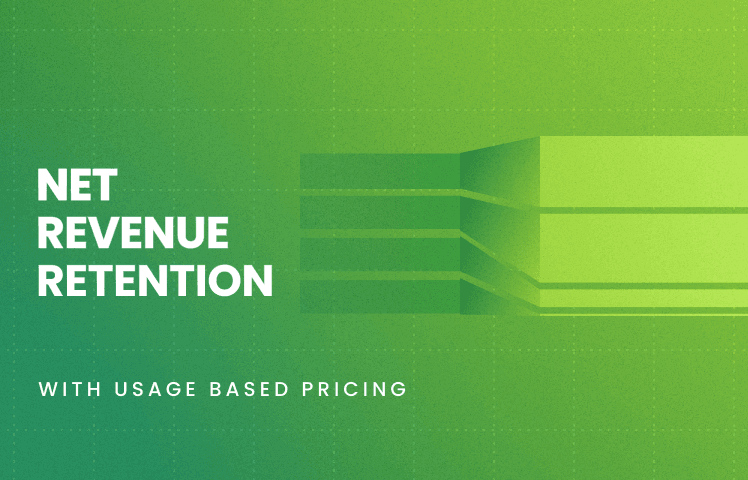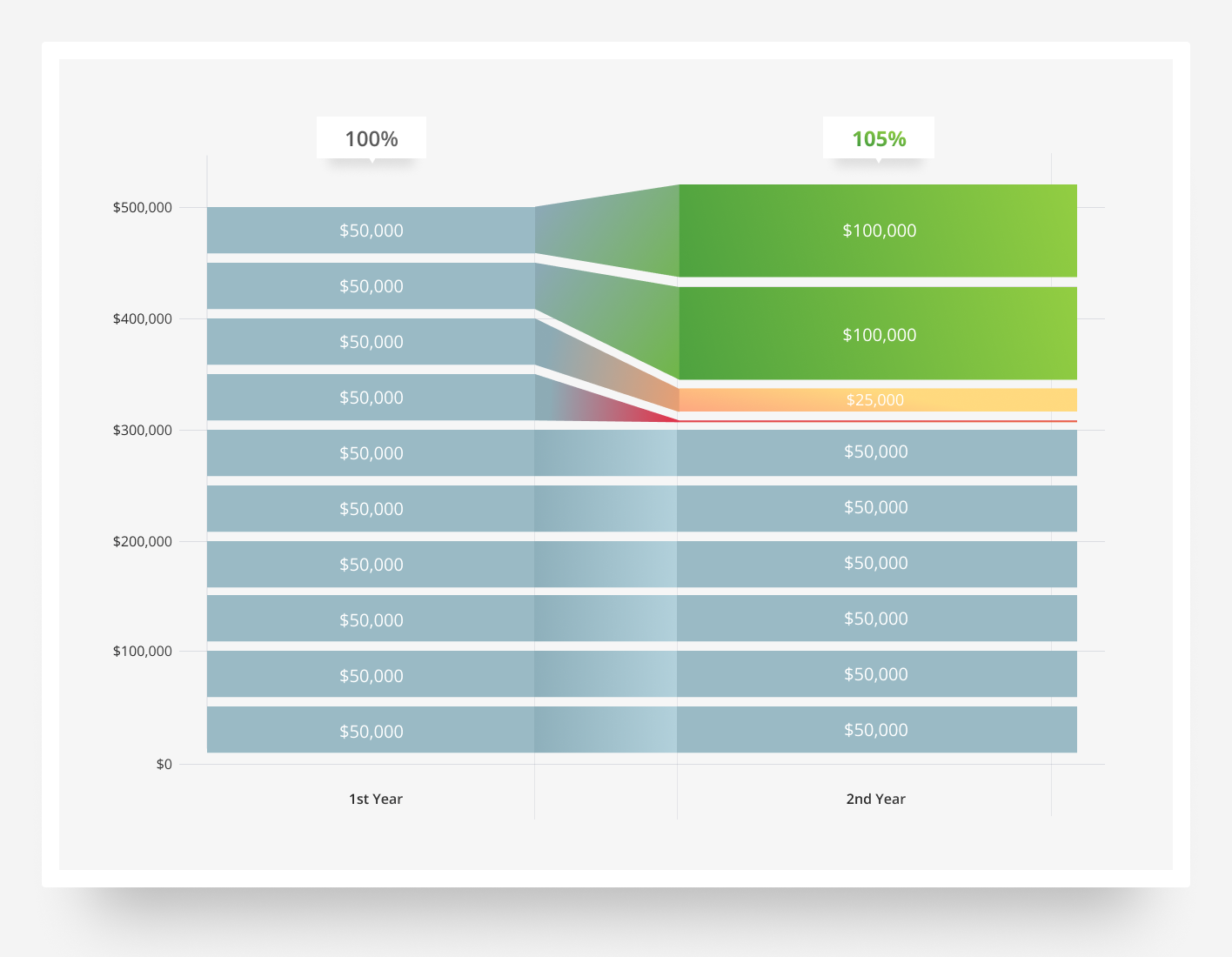
In 2023 SaaS business's attention is shifting from acquisition to expansion as the economy slows. Today most companies find it easier to delight existing customers and upsell them than acquire new ones. The catch is that you can only upsell customers you still have and didn't churn. The name of the game is retention and expansion. And the metric to follow is Net Revenue Retention (NRR). In this article, we will dive deep into the NRR, its synergy with usage-based pricing, and the data-driven approach necessary across all departments, including engineering, sales, and customer success, to increase it.
Net Revenue Retention (NRR)
Net Revenue Retention (NRR) paints a comprehensive picture of how many existing customers remain loyal over a specified period. It encapsulates the effects of expansion revenue, downgrades, and cancellations.
You can calculate your NRR as a percentage like:
Here's a breakdown:
- Starting MRR: Monthly Recurring Revenue at the start of the period.
- Expansion MRR: Additional MRR gained from existing customers (e.g., from upsells).
- Churn MRR: MRR lost from customers who cancelled.
- Contraction MRR: MRR reduced due to downgrades or discounts.
For example, you sign annual contracts. In the first year, you have ten customers with a $50,000 annual contract. That's $500,000 in annual revenue. In the second year, one customer decides to keep their contract, one to downgrade to $25,000, and two to upgrade to $100,000. Your new annual revenue will be:
And your NRR will be

The revenue growth illustrates the power of retention and expansion. As our example shows, despite no new customer acquisition, by focusing on existing customers we can grow our revenue even during challenging times.
How to increase your Net Revenue Retention
1. Embrace Usage-Based or Hybrid Pricing
Usage-based pricing can be a catalyst for improved NRR due to:
- Organic Account Growth: Customers naturally use more of your service, leading to higher billing.
- Reduced Churn: Financially strapped customers can adjust usage to fit budgets, leading to downgrades instead of cancellations.
Value-based or usage-based pricing also solves many challenges around expansion; your customer can grow and increase your NRR without relying on manual upselling.
2. Retention requires data-driven customer success
Retention forms the bedrock of NRR growth. Retaining customers during challenging times is essential, as acquiring new customers is much more difficult. You can only expand customers who are still with you, so retention is vital to increase NRR. This is why the best customer success teams are data-driven; For example, you want to detect churn early to act on it and reverse the process. Here, data plays a pivotal role. Top-notch customer success teams harness data to:
- Spot early signs of potential churn and negative change in usage patterns.
- Monitor long-term trends, identifying users whose engagement is waning.
- Gauge the impacts of customer support interactions.
Being data-driven is especially important with usage-based pricing, where customer success and sales teams must separate between seasonality, noise, and actionable trends. Here at OpenMeter, we like to say that use-based pricing is a horizontal challenge impacting every team in your organization, from engineering to RevOps and product. Having fresh, good-quality usage data is key.
3. Find upselling opportunities
The most common opportunity is when a customer has an overage, yet many companies don’t track customer usage against tier limits. Even with usage-based pricing without tier limits, you still want to track consumption to identify who would be better off on long-term enterprise contracts. You want to know how ample the opportunity is for expansion. Calculating this can be challenging if you sell multiple plans or your sales team offer one-off discounts.
4. Start outreach early enough
It's good practice to start customer outreach before they run out of pre-purchased credits or hit tier limits. You probably don't want to provide your service for free when your customer reaches such a limit or surprise them with an overage bill or cap their service usage.
Data-driven companies forecast when customer overage will occur and start the outreach early on, the enterprise sales cycle can take a long time and create ambiguity between vendor and customer.
5. Transparency helps to avoid refunds
We discussed earlier how good customer relation and data-driven customer success helps to increase NRR. Having visibility into usage is also necessary on the customer side if you adopt usage-based pricing.
We heard many stories about customers asking businesses to prove the billed usage or waive a portion due to unexpected consumption spikes. This is not good for either party: customers feel vulnerable, while providers must manage tension and prove they didn't make metering mistakes. Sometimes usage spikes happen because software bugs or DDoS attacks lead to unexpected bills. In this case, many customers ask providers to waive the bill or share the cost. It's not a great situation and can be avoided by providing real-time usage transparency.
When expensive vendors don't provide visibility into usage, in some cases, customers take action on their own hands and implement their usage metering to keep their vendor spending within a budget.
As a SaaS provider, it's a best practice to provide usage transparency like:
- Real-time usage dashboard
- Provide usage forecast
- Allow setting threshold notifications
Surprises and refunds are significantly lower for SaaS providers that offer a way for their customers to track their consumption and get notified about anomalies.
Conclusion
In the evolving SaaS landscape, the focus has shifted from merely acquiring to earnestly nurturing. NRR has emerged as a critical metric to gauge a company's prowess in retention and expansion. Coupling it with usage-based pricing can further amplify growth by enabling organic account growth, and customers can adjust usage to fit budgets instead of cancellations.
However, the backbone of usage-based pricing is a data-driven approach, ensuring all departments, from sales to customer success, are in sync with customer usage trends.
For example, customer success and sales teams must separate seasonality, noise, and actionable trends. Here at OpenMeter, we like to say that use-based pricing is a horizontal challenge impacting every team in your organization from engineering to RevOps and product.
OpenMeter enables SaaS companies to accurately meter customer usage and feed real-time data into their billing, product, and analytics solutions. Enabling their teams to make data-driven decisions.
